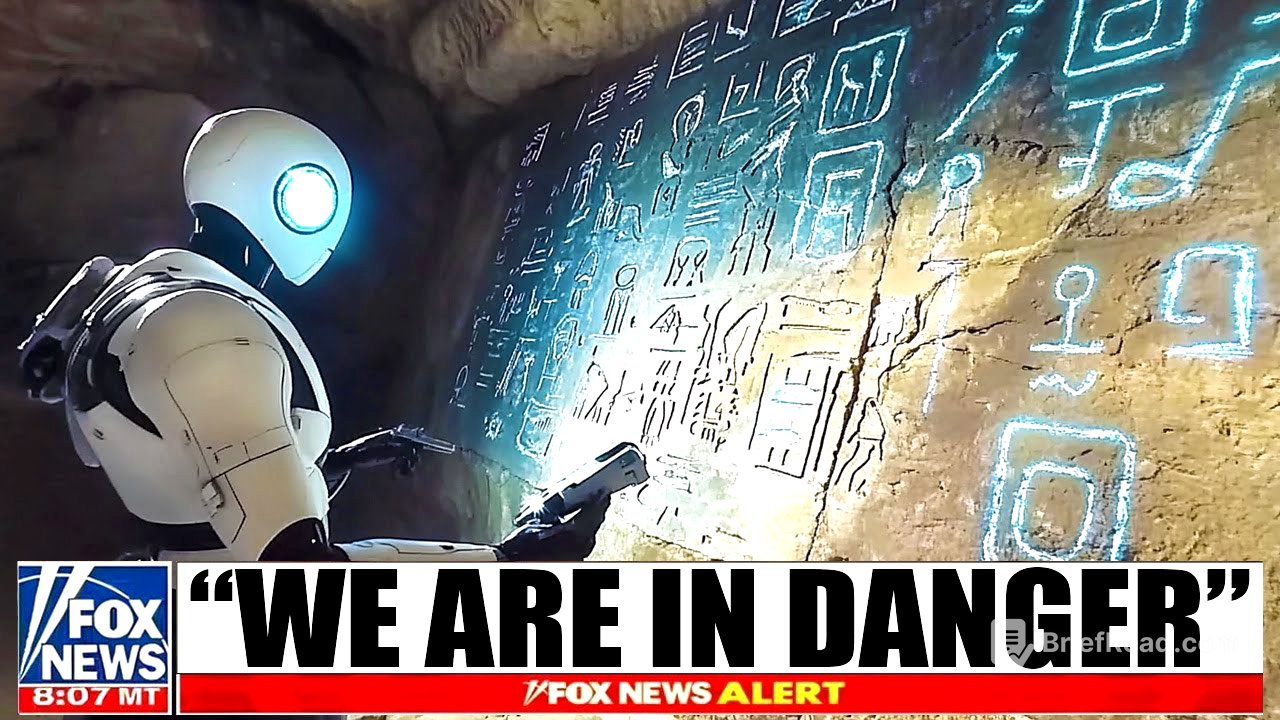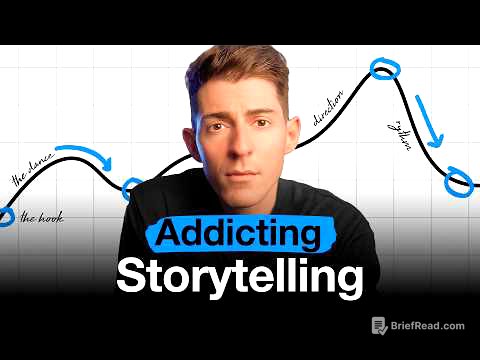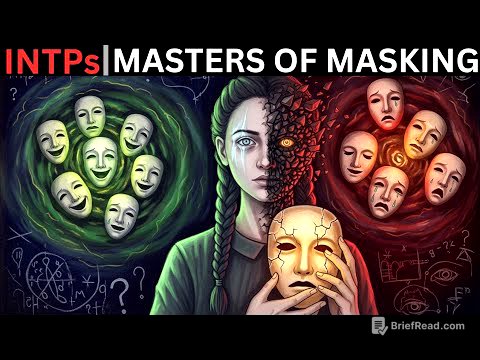TLDR;
This video explores how artificial intelligence is revolutionizing the decipherment of ancient languages and scripts. It highlights 20 different cases, ranging from well-known scripts like Egyptian hieroglyphs to more obscure ones like the Danube script and the Voynich manuscript. AI is used for pattern recognition, translation, and even uncovering hidden texts, offering new insights into ancient civilizations.
- AI is helping to decipher ancient languages and scripts.
- The technology is being used to uncover hidden texts and patterns.
- This is providing new insights into ancient civilizations.
Intro [0:00]
The video introduces the idea that ancient texts, once considered lost, are now being deciphered with the help of artificial intelligence. It suggests that these texts may reveal secrets that we are not yet ready to hear. The video promises to explore ancient languages and how AI is helping to bring them back to life.
The Danube Script [1:02]
The Danube script, found on artifacts along the Danube River, is a potential writing system dating back over 7,000 years. For decades, experts debated whether the symbols were writing or doodles. AI analysis revealed structure, syntax, and repeated sequences, suggesting it is a language. If confirmed, it would be the oldest known form of written communication. The purpose and the writers of this code remain unknown, as it disappeared without a trace.
The Herculanium Scrolls and the Vuvius Challenge [2:16]
Charred papyrus scrolls from Herculanium, buried by the eruption of Mount Vesuvius in 79 AD, have been indecipherable for nearly 2,000 years. In 2023, the Vesuvius Challenge was launched, offering over $1 million to anyone who could use AI to virtually unroll the scrolls. Luke Ferriter, Yousef Nater, and Julian Schilliger successfully decoded over 2,000 Greek letters, revealing the voice of Philodemus, an Epicurean philosopher. This breakthrough marks a resurrection of voices silenced by the eruption.
Acadian Cuneiform [3:47]
Acadian cuneiform, found on over 500,000 clay tablets in Mesopotamia, is difficult to translate, with only a few hundred people able to do so. In 2023, AI models were developed to translate Acadian texts, which was written in the Babylonian language. These models, trained on thousands of translated texts, provide fast and accurate translations. Various teams are using AI, 3D modeling, and neural networks to recognize signs from the tablets. While some seek magic spells, most translations reveal trade agreements, tax logs, and parts of the Epic of Gilgamesh.
The Dead Sea Scrolls [5:15]
The Dead Sea Scrolls, discovered in the 1940s, are ancient texts written by the Essenes. AI researchers at the University of Groningen discovered that the Great Isaiah Scroll was written by two scribes, not one, based on tiny variations in the Hebrew letter "Aleph". This suggests organized writing teams existed and AI can detect emotional shifts in pen pressure and style, revealing not just what was written, but how the scribes felt.
The Indiscript [6:25]
The Indiscript, used by the Indus Valley civilization, appears on seals, pottery, and tablets, but lacks a Rosetta Stone for translation. Researchers have used Markoff models and AI to analyze the inscriptions, revealing language-like behavior and recurring structures. While challenges remain due to short inscriptions and an unknown base language, AI is making progress in symbol segmentation, with a million-dollar prize awaiting whoever cracks the code.
The Marowoitic Language [7:46]
The Meroitic language, which flourished in ancient Nubia (modern Sudan), had two scripts: hieroglyphic and cursive. Despite being known for over a century, it remained undecoded due to the lack of bilingual texts and dictionaries. Researchers at MIT's CSIL lab are using algorithms to detect structural logic and statistical relationships between symbols. Early results show promise, and AI is gradually breaking the silence surrounding this forgotten tongue.
The Protoelomite Script [8:54]
Proto-Elamite, one of the world's oldest writing systems from ancient Iran, dates back to around 3,100 years BC. The wedgelike signs were carved onto clay tablets. Despite a century of study, the code remained uncracked. AI is now being used to analyze ultra-detailed images of the tablets, recognizing subtle grooves and glyphs. Algorithms are also deciphering the numerical systems, providing context for trade and economy records. While the full script remains a mystery, AI is helping to classify symbols and reveal the tablets' secrets.
Ancient Egyptian Hieroglyphs [10:24]
Ancient Egyptian hieroglyphs are being brought into the digital age with Fabricius, an AI-powered tool developed by Google Arts and Culture and others. Fabricius teaches users about hieroglyphs and uses pattern recognition to match them with known translations. It connects to a cloud-based database and offers multiple translation options, streamlining the translation process. This tool makes it easier for scholars and enthusiasts to understand one of history's most iconic languages.
Rongorongo [11:56]
Rongorongo, a script from Easter Island discovered in the 1860s, is carved into wooden tablets with a unique snaking direction. With only two dozen tablets surviving and the culture that created them silenced, there is no Rosetta Stone or living speakers. AI is being used to isolate and catalog individual glyphs, detecting similarities between Rongorongo and known writing systems to spot potential linguistic traits.
The Ismian Script [13:24]
The Ismian script, also called Epi-Olmec, appears on artifacts from Mesoamerica dating between 500 BC and 500 AD. Its status as a true writing system is debated. Researchers at MIT's CSA lab have models that can analyze such undeciphered, scarce, and ancient scripts. These models use evolutionary linguistics to trace possible roots and structures, analyzing symbol order, frequency, and morphology.
Oracle Bone Script [14:44]
The Oracle Bone Script, China's oldest known writing from the Shang Dynasty, was carved on turtle shells and ox bones for divination. In 2024, the AI system OBSD was developed to match these characters to modern Chinese equivalents. Trained on a massive image library, the AI can fill in gaps where carvings are damaged. Another tool provides a platform to study bone fragments side by side, finding overlaps and matches in real time.
Linear B and Yugaritic [16:14]
Linear B, used in Mycenaean Greece, was cracked in 1952. In 2019, an MIT team built an AI model to translate it faster, achieving significant success. Ugaritic, an ancient Semitic script, was deciphered by an MIT team in 2010 using a machine learning model that aligned it with Hebrew. Both projects used comparative linguistics AI to match word roots, grammar, and meaning across time and languages.
The Nazca Lines [17:36]
The Nazca lines are massive earth drawings in Peru's Nazca desert. In 2024, AI was used to uncover 303 new geoglyphs, adding to the 430 previously identified over a century. Image recognition software was trained on aerial photos to spot patterns humans missed. The geoglyphs depict animals, people, and ceremonial scenes, and AI is helping to find them faster.
Inca Kipus [19:08]
The Inca used knotted strings called quipu as their form of record-keeping. Once thought to be just counting tools, researchers now suggest they may be phonetic or narrative. AI is helping to map out the subtle patterns in knot placement and spacing, revealing complex structures. These knots could hold syllables and tell stories, and AI may finally be able to decipher them.
The Palumsts [20:21]
Palimpsests are ancient manuscripts with overwritten texts. Multi-spectral imaging and AI are used to reveal the original, hidden texts. In 2021, a new AI technique using deep generative networks was developed to isolate the overwritten layers, making hidden texts legible without damaging the original page. This method is being applied to hundreds of palimpsests, rediscovering lost knowledge.
Bashinji Nushu [21:47]
Nushu, a hidden language used by women in southern China, was dying out by the 21st century. In 2025, Dartmouth College launched Nushu Rescue, an AI initiative to revive the script. GPT4 Turbo was trained to translate Nushu into Chinese with minimal data, achieving nearly 50% accuracy. Another project simulated how women might have evolved the script across generations, preserving cultural heritage.
The Voinich Manuscript [23:00]
The Voynich Manuscript is a 600-year-old book filled with bizarre plants, zodiac signs, and nude women, written in an unknown language. In 2018, AI claimed that 80% of the words had Hebrew equivalents, but Hebrew scholars disputed the translation. Another theory suggested it was written in Proto-Romance, but this was also met with objections. The Voynich Manuscript remains a mystery.
Mayan Glyphs [24:31]
Mayan glyphs are visually complex, and decoding them has traditionally been a slow process. The Artful Algorithms project is using AI to isolate and classify individual glyphs from scanned stonework. Another project is fine-tuning models to identify and extract glyphs with pixel-level precision. These AI breakthroughs are helping to identify glyphs in seconds, aiding in the understanding of Mayan stories.
The Cypro Manoan Script [25:48]
The Cypro-Minoan script, used on the island of Cyprus over 2,000 years ago, has baffled scholars for over a century. Recent studies using unsupervised deep learning suggest it may be one language. AI is being used to analyze the visual structure of signs, uncovering consistent rules and stylistic features. Analysis hints at potential relationships with Linear A and early Semitic languages.
Atruskin [27:05]
The Etruscans, who ruled central Italy before the Romans, left behind thousands of inscriptions, but their language remains a mystery. As a language isolate with no known relatives, AI is being used to detect statistical patterns in Etruscan texts. AI can flag recurring suffixes, mark potential verb forms, and suggest meanings based on word clusters, helping to reconstruct grammar and understand Etruscan culture.









